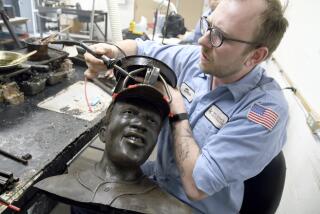Michelangelo’s Model for ‘David’ Believed Found
- Share via
NEW YORK — An eight-inch-tall stucco model that is believed to be the original study for Michelangelo’s famous sculpture “David” has been found after being missing for almost 300 years, a noted art historian said Friday.
Frederick Hartt, professor emeritus of art history at the University of Virginia, said he had “no doubt, none whatsoever” that the tiny torso missing both arms and portions of its legs is authentic and is in all likelihood the only surviving small-scale model made by Michelangelo.
Renaissance historians had thought that the model of the monumental statue in Florence was destroyed in 1690 when a fire gutted 27 rooms of the Palazzo Vecchio, the home of Duke Cosimo I de’ Medici.
Hartt said he believed the model, now owned by the Davos Foundation in Switzerland, fell into the rubble and was lost in the debris. At some later date, it was buried and its limbs were broken during exhumation.
The gray-haired professor said he first thought the tiny model was a “fragment of Greek sculpture from the Fifth Century.” But then he said he observed similarities to Michelangelo’s “David.”
“It didn’t take me more than a minute before I realized what this had to be,” he told a crowded news conference at the New York Academy of Sciences in Manhattan. “I started to tremble, the discovery was so great. I kept asking myself ‘Can it be real? Am I wrong?’ I didn’t sleep that night. I kept asking all the most inconvenient questions I could ask, and it passed every test.”
Examined for Nine Months
Hartt examined the sculpture for nine months. Scientists at the University of Bordeaux in France determined that it was made of stucco and said the statue’s luster also suggests the use of alabaster, a form of gypsum quarried near Volterra, which was in Florentine territory during the 16th Century, when Michelangelo sculpted “David.”
The professor presented photographs and his evidence of the statue’s authenticity to five Renaissance scholars at the New York Academy of Sciences on Thursday before meeting the press on Friday. The scholars listened intently but asked to see the model, hoping to dismiss the possibility it might be a copy by a very talented student of Michelangelo or by a more modern sculptor.
“If it is generally accepted as a Michelangelo, it would be like discovering Shakespeare’s first draft for ‘Romeo and Juliet,’ ” said Leo Steinberg, professor of art history at the University of Pennsylvania, who attended the meeting.
“It is not a copy,” Hartt insisted Friday, but he admitted that some in the art world remain unconvinced. “They will have to study it themselves. You can’t spring a thing like this on scholars and expect them to come chiming in with a chorus of praise,” he said.
Exhibitions Planned
Hartt said the Davos Foundation is negotiating with several museums to arrange exhibitions.
He said that being the first person to identify the sculpture “is the most thrilling thing of my life . . . . Within its tiny compass I could feel in germ not only the marble David but the whole race of heroic beings with whom Michelangelo populated his famous classic compositions.”
When Michelangelo’s huge marble statue of David was unveiled in 1504, it established the sculptor as the leading Florentine artist of the 16th Century. The statue had special political significance. Florence had recently freed itself from the Medici family’s rule and had instituted a republican government. David, the boy-hero with his slingshot, personified the liberation of the people from tyranny.
Hartt explained that there are subtle but definite anatomical differences between the tiny model and the huge finished sculpture.
Can See Changes
“You can see Michelangelo made some changes,” Hartt said Friday. “The chest of the model is much more arched. He has sucked in his stomach muscles. He has more texture throughout the abdominal wall . . . Michelangelo must have had a natural living model standing in front of him.”
The professor said he believed the model was presented in 1501 by the sculptor to officials of the Florence Cathedral in an effort to secure the commission for the huge version of David. The 26-year-old artist then enlarged the model in proportion to the marble block he used for his masterpiece.
In 1553, the model was officially recorded in an inventory of the collection at Florence’s Palazzo Vecchio, the official residence of the duke of Florence. It was listed in subsequent inventories of the collection through 1666. After the Palazzo Vecchio fire on Dec. 17, 1690, it is believed the model fell into the rubble and was damaged by flames. Chemical analysis of the model shows that it was burned, Hartt said.
The statue was exhumed at an unknown date, and was acquired in 1921 by the Swiss composer Arthur Honegger, who apparently did not know it might be an original by Michelangelo, although he did recognize that it had some connection with the statue of David. Honegger kept it on his piano.
Purchased From Heirs
Hartt said the model was purchased from Honegger’s heirs by the Davos Foundation in 1985. The price has not been disclosed. Hartt was asked Friday what he thought the model was now worth. “Something I’d only want to dream of,” he replied, citing no figure.
Hartt said the model dispels a myth about Michelangelo.
“There is the idea he went at the marble with just a wonderful idea in mind,” the professor said. “But it is impossible. This ties this immense craftsman to his actual processes.”
More to Read
The biggest entertainment stories
Get our big stories about Hollywood, film, television, music, arts, culture and more right in your inbox as soon as they publish.
You may occasionally receive promotional content from the Los Angeles Times.










